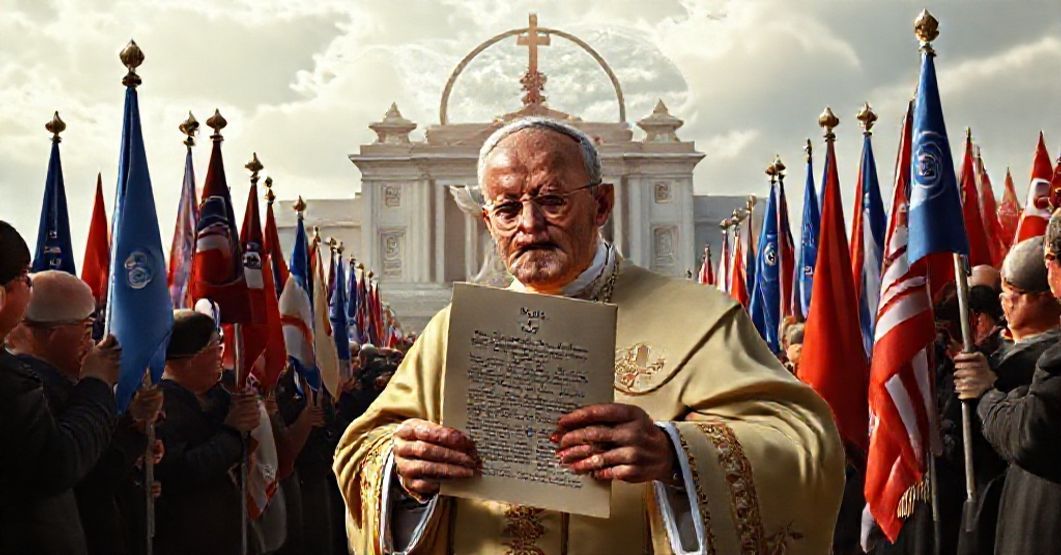Antipopes of the Antichurch



















Timeline of this heretical pontiff
Encyclical Letters
+ 15 posts1959
+ 7 posts1961
+ 4 posts1962
+ 2 posts1963
+ 2 postsApostolic Exhortations
+ 3 postsApostolic Constitutions
+ 93 posts1958
+ 6 posts1959
+ 87 postsMotu Proprio
+ 15 posts1958
+ 1 posts1959
+ 1 posts1962
+ 11 postsApostolic Letters
+ 151 posts1958
+ 4 posts1959
+ 63 posts1960
+ 78 posts1961
+ 1 posts1962
+ 4 posts1963
+ 1 postsSpeeches
+ 99 posts1958
+ 2 posts1959
+ 26 posts1960
+ 29 posts1961
+ 16 posts1962
+ 24 postsMessages
+ 6 posts1959
+ 4 postsHomilies
+ 4 postsLetters
+ 152 posts1958
+ 1 posts1959
+ 48 posts1960
+ 32 posts1961
+ 31 posts1962
+ 30 posts1963
+ 10 postsNot categorized
+ 1 posts1958
+ 1 postsNews feed


Pacem in terris (1963.04.11)
Pacem in terris, issued by the usurper antipope John XXIII in 1963, presents itself as a universal charter on peace grounded in “order,” “truth,” “justice,” “charity,” and “freedom,” addressed not only to nominal Catholics but explicitly “to all men of good will.” It develops a broad catalogue of “human rights,” a natural-law flavored but systematically horizontal doctrine of person and community, endorses democratic participation, international organizations (notably the UN), and the construction of a global public authority, while proposing disarmament and a new world order as the path to peace. Its defining gesture is to shift the axis of Catholic teaching from the sovereign rights of Christ the King and the infallible Magisterium to the autonomous dignity and rights of man, thereby inaugurating the political theology of the conciliar sect. This text is not a message of Catholic peace; it is the manifesto of a new religion of humanity that betrays the integral doctrine of the Church before 1958.


Mater et magistra (1961.05.15)
The document published under the name “Mater et Magistra” (15 May 1961) presents itself as a continuation and development of Leo XIII’s Rerum Novarum, Pius XI’s Quadragesimo Anno, and the social teaching of Pius XII. It offers a lengthy treatment of economic modernization, “socialization,” state intervention, workers’ rights, agricultural policy, international aid, demographic growth, and global cooperation, framed as an adaptation of Christian social principles to contemporary conditions. It lauds scientific-technical progress, proposes a globalist conception of social justice between nations, promotes an enlarged role for public authorities, and systematically prepares the conceptual ground for the later conciliar agenda of “reading the signs of the times” and restructuring society through dialogue and development. In doing so, it subtly but decisively replaces the supernatural, hierarchical, and confessional order of Christ the King with a horizontal project of humanitarian, democratic, technocratic “Christian” social reform.


Aeterna Dei sapientia (1961.11.11)
The text presented is the Latin encyclical “Aeterna Dei sapientia” of antipope John XXIII, issued 11 November 1961 on the 15th centenary of the death of St Leo the Great. It praises St Leo I as pope, doctor, defender of Christological orthodoxy and of Roman primacy, and uses his figure as a theological and rhetorical platform to prepare and legitimize the convocation of the so‑called Second Vatican Council and to promote a program of “visible unity” among all who bear the Christian name. The entire document culminates in the claim that the same faith, the same worship, and the same obedience to the Roman See require “all Christians” to converge toward one fold under one visible head, with Vatican II presented as the privileged instrument of this restoration of unity.


Princeps Pastorum (1959.11.28)
Princeps Pastorum is presented as an encyclical of John XXIII on Catholic missions, celebrating forty years since Benedict XV’s Maximum illud, praising the growth of “indigenous clergy” and laity, urging adaptation to local cultures, promotion of Catholic Action, social initiatives, and collaboration between missionaries and emerging local hierarchies, all under the banner of a universal, pacifying, and “non-foreign” Church presence. Behind this language, the text systematically instrumentalizes the missions as a vehicle of the coming conciliar revolution, diluting the supernatural end of the Church into sociological development and preparing a humanistic, de-clericalized, democratized “missionary” neo-church: this is its core betrayal.
Varia
Announcement:
– News feed –implemented
– Antipopes separate web sites with their all documents refutation – in progress
